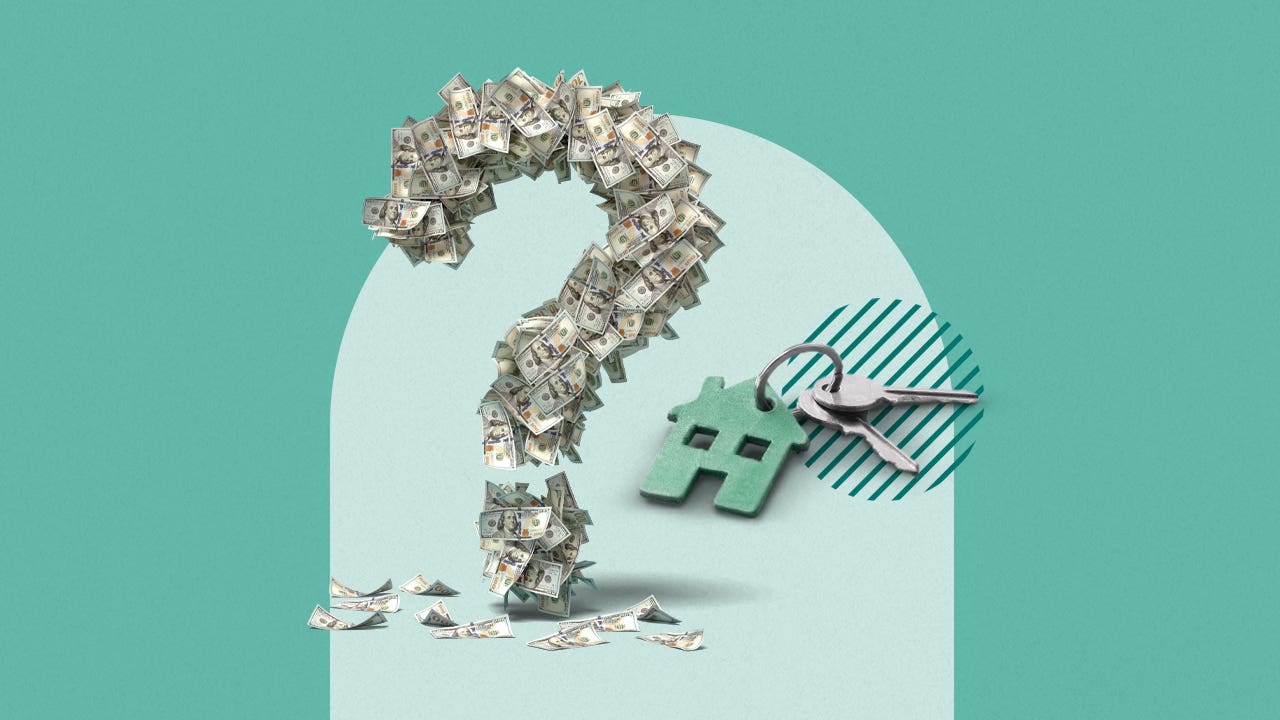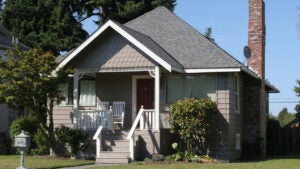How much money do you need to buy a house? 6 costs to calculate




Determining how much money you need to buy a house has always been daunting for first-time homebuyers, and it doesn’t seem to be getting much easier in 2025. Mortgage rates are still hovering around 7 percent — even after the Fed cut rates three times to close out 2024 — and home prices are still sky high.
But despite those challenges, buying a home is still a smart move that can help you lay a strong financial foundation for your future. Here’s a rundown of six key costs to calculate as you figure out exactly how much house you can afford.
Down payment
How much money do you need to buy a house? The answer will be different depending on each buyer’s circumstances, but to figure out the math for your particular situation, the down payment is a good place to start. This is the amount of money you contribute to the home purchase upfront. By increasing the size of your down payment, you lower the amount of money you need to borrow — which, in turn, lowers your monthly payments over the course of the loan. Lenders like to see larger down payments because they indicate a lower level of risk if you default on the loan.
How much should you put down?
It’s a common misconception that you must put down 20 percent of the home’s purchase price. But that’s not necessarily true, which is a good thing for cash-strapped buyers: For a $400,000 home, a 20 percent down payment would require $80,000 paid upfront.
Several low- and no-down payment mortgages allow for much less money upfront, though. For example, some conventional mortgage programs backed by Fannie Mae and Freddie Mac require just 3 percent down. (The caveat with these is that they can have income restrictions and require a higher credit score.) According to data from Realtor.com, the median home down payment in the third quarter of 2024 was 14.5 percent of the purchase price.
Ultimately, figuring out your down payment means thinking about the rest of your budget. You shouldn’t spend every penny you have to cover your down payment — you’ll stretch yourself too thin to cover all your other expenses. Plus, a lender will evaluate your entire financial scenario and want to see some cash reserves in case you find yourself in a tough spot.
Tips to build your down payment fund
Whether you put down 20 percent or 3 percent, coming up with that big upfront cost requires some work. Consider these helpful tips to save for a down payment:
- Look for local support: Browse first-time homebuyer programs in the city and state where you want to buy. You may qualify for grants or zero-interest loans to put toward your down payment and closing costs.
- Identify every expense you can cut: Saving more starts with spending less. Can you cancel your cable? Are you overpaying for your cell phone service? Could you try to dine out less? Look at your weekly and monthly expenses to find ways to trim your spending.
- Put your savings to work: Rather than saving in an account that pays little to no interest, compare interest rates on options where you can park your money. From CDs to high-yield savings accounts, every extra penny counts. Just be sure you’ll have access to the funds when you need them.
- Ask for help: If you have a relative or close friend who has the money — and is willing to give it to you with no strings attached — a gift can be used for the down payment. Plan to submit a gift letter that explains you won’t need to pay it back, so that the lender can be sure it is not a loan.
Closing costs
The down payment isn’t the only upfront expense you need to consider. You can expect to pay 2 to 5 percent of the home’s price in closing costs. Closing costs vary widely based on the location where you’re buying, however. For example, while the average closing costs in New York are around 3.1 percent of the purchase price (not including Realtor commissions), they’re just 0.8 percent of the price in Missouri.
Closing costs include a range of fees charged by your lender and other companies involved in approving your loan and finalizing the sale. These can include fees for the following:
- Appraisal
- Credit check
- Loan application
- Underwriting
- Loan origination
- Title search
- Title insurance
Closing costs vary from lender to lender, so shop around, paying close attention to the fees to see where you might be able to save. And remember, if you use a real estate agent or attorney along the way, their fees will be due at closing as well.
Can you avoid closing costs?
Homebuyers can’t avoid closing costs completely, but you can avoid paying them all at once. You may also be able to negotiate at least some closing costs, especially in a buyer’s market.
If coming up with cash to pay for closing costs seems daunting, ask your lender about no-closing-cost options. Some lenders will roll the expenses into the overall loan, so you pay little by little each month. Just keep in mind that doing so will cost you more in the long run, since you’ll be paying interest on the additional amount.
Prepaid costs
In addition to the typical closing costs, some ongoing fees may need to be paid upfront, at least partially. These are known as prepaids and can include a certain time frame’s worth of homeowners insurance premiums and property taxes, for example. For these monthly recurring expenses, your lender will likely hold your funds in escrow until the bills come due. You’ll also prepay interest on any days remaining through the end of the month. For example, if you close on April 20, you will prepay on interest through April 30.
Earnest money
Prospective buyers also pay an earnest money deposit to demonstrate serious intent to purchase a home. You’ll typically need to pay 1 percent of the home’s agreed-upon purchase price. But earnest money is not an additional expense, it’s just paying a bit of your expenses early. You make the deposit within a day or two after your offer is accepted, and at closing, it is credited toward your payment.
Cash reserves
Your lender will want to see that you have enough remaining financial reserves to cover your mortgage payments in the event of an emergency or change in income. Mortgage reserves are typically measured in months: For example, if you have $7,200 in a savings account after closing on your house, and your monthly payment is $1,200, you have six months of reserves. Non-liquid assets, like funds that can only be withdrawn upon retirement, generally don’t qualify as reserves.
Moving costs
In addition to actually buying a home, you need to budget for the costs of moving into it. Prices vary based on the size of your home, the distance you’re moving, the weight of your items and whether you’ll need storage for a time in-between. According to HomeAdvisor, a typical move in 2025 ranges between $884 and $2,569, with the average being about $1,713.
Be sure to factor in the costs of small expenses that add up in aggregate, such as boxes, packing tape and bubble wrap. You should also consider the potential cost of changing your address on various accounts and IDs, and look into how bills like auto insurance might change with a new address as well.
And keep in mind that, while local moves might be expensive, out-of-state or cross-country moves are much costlier. Long-distance moves also incur additional expenses along the way, such as the cost of lodging, gas or airfare as you move from Point A to Point B.
Mortgage payments
As you’re thinking about how much money you need to buy a house, it’s crucial to know how much it will cost you every month, not just on closing day.
If you have a fixed-rate loan, your monthly mortgage payment is one of your most predictable ongoing costs. Bankrate’s mortgage calculator can help you figure out how much you’ll owe each month. For example, if you borrow $240,000 and finance it with a 30-year, fixed-rate mortgage at 7 percent, you’d pay $1,597 in monthly principal and interest.
Your mortgage rate has a big impact on your monthly mortgage payment, which makes it crucial to shop with multiple lenders for the best mortgage rate. For example, if you got that same $240,000 loan at a 7.5 percent rate, the payment for monthly principal and interest increases to $1,678.
According to a Fannie Mae study, more than a third of homebuyers received only one mortgage quote. Failing to comparison-shop could cost you thousands over the life of the loan.
Mortgage insurance
If you put less than 20 percent down, in addition to paying the principal and interest, your mortgage payment will likely include a fee for private mortgage insurance (PMI). This protects the lender in case you ever cannot pay the loan back. The cost of PMI varies based on your credit and your loan, so be sure to ask your lender for an estimate of how much it will add to your bill.
Ongoing homeownership costs
Finally, you’ll also need to account for the ongoing costs of homeownership. Consider budgeting for emergency home repairs and maintenance in the amount of 1 percent or more of your home’s value every year. For example, on a $300,000 home, your budget for maintenance-related items would be $3,000 annually.
Be sure to also factor in regularly recurring costs like homeowners insurance, property taxes, HOA fees (if your property is part of an association), utility bills and general upkeep.
Preparing to buy a home
Once you’ve answered the big question — how much money do you need to buy a house? — it’s time to answer another one: Are you ready to make the actual purchase? Here are some steps to take to prepare to buy a home.
- Check your credit: Mortgage lenders use your credit score, along with other criteria, to determine your interest rate. The higher your score, the lower a rate you’re likely to get. You can get your credit score from each of the three major credit reporting agencies, an online service or your bank. If your score is on the lower side, try to take steps to increase that number before seeking out a mortgage.
- Create a budget: Take a look at all your expenses to create a realistic budget. Many experts recommend following the 28/36 rule, which holds that you should spend no more than 28 percent of your gross monthly income on housing and no more than 36 percent on overall debt.
- Start saving for a down payment: You’ll typically need at least 3 percent of the purchase price of the home as a down payment. The more you are able to put down upfront, the less you’ll have to borrow.
- Get preapproval: Getting preapproved for a mortgage provides you with a better idea of how much home you can truly afford, and also makes you a more serious potential buyer to sellers. Start by shopping around and getting quotes from at least three lenders.
- Be willing to compromise: Home prices are high and it’s still a seller’s market in many parts of the country, which means you may need to let go of things you once thought were must-haves, like a two-car garage or a finished basement. Remember that once you own the property, you can always work to make improvements and upgrades in the future.
Next steps
When shopping for a home, it’s invaluable to work with a local real estate agent who knows your market well. Ask family and friends for referrals, and interview several professionals before choosing the Realtor who’s right for you.
It’s also smart shop around and compare rate offers from at least three different lenders before moving forward. Snagging a lower rate upfront can save you thousands in the long run.
Finally, make sure to account for both upfront and ongoing expenses when creating a budget, and take a close look at your monthly finances to make sure that carrying a mortgage and paying for continuing expenses won’t be a financial burden long-term.
FAQs
Why we ask for feedback Your feedback helps us improve our content and services. It takes less than a minute to complete.
Your responses are anonymous and will only be used for improving our website.
You may also like

What is the 28/36 rule for home affordability?

How much does it cost to sell a house?

What income do I need to afford a $250K house?

